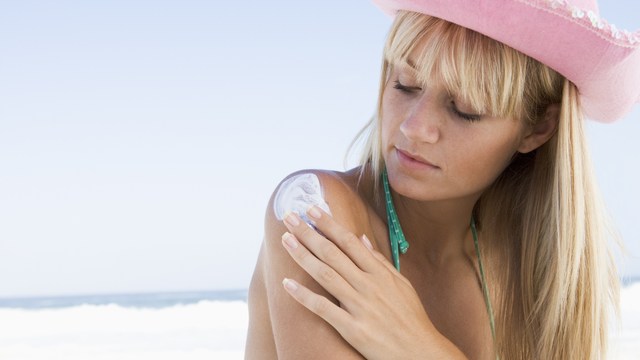 MonkeyBusiness Images/PhotoSpin
MonkeyBusiness Images/PhotoSpin
Severe childhood and teenage sunburns are more than twice as likely to lead to skin cancer as severe sunburns later in life. Get five or more blistering sunburns before age 20 and your risk could soar by 80 percent, a new study found.
Intense, blistering sunburns have long been linked to malignant melanoma, the most dangerous and deadly form of skin cancer.
Previous studies had found that children who had been seriously sunburned were at greater risk for melanoma than children who were not. But a new Brown University study is among the first to show those health dangers are much greater when intense sunburns occur in adolescent Caucasian girls than when they occur later in life.
While anyone can develop skin cancer, those with light skin, blue eyes and who tend to freckle are at the greatest risk. Researchers found that sun exposures in both early life and adulthood were predictive of non-melanoma cancer risks, whereas melanoma risk was predominantly associated with sun exposure in early life.
The findings further suggest advising parents to pay more attention to protecting their kids from early-life sun exposure as one way to lessen the likelihood they will develop skin cancer in adulthood.
Symptoms of sunburn — red, tender and blistering skin, chills, nausea fever and rash — are usually temporary, but the skin damage left behind is often permanent and can have serious long-term effects, including disfiguring and dangerous types of skin cancer.
The first sunburn signs may not appear for a few hours after exposure, with the worst pain showing up from 6-48 hours after sun exposure. By the time the skin starts to become painful and red, the damage is done, experts say. Often the full effect of a sunburn may not be known for 24 hours or longer.
“Older individuals should also be cautious with their sun exposure, because cumulative sun exposure increases skin cancer risk as well,” said Abrar A. Qureshi, M.D., MPH, professor and chair of the Department of Dermatology at Warren Alpert Medical School of the Brown University and Rhode Island Hospital in Providence, and the study’s lead author.
Melanoma is linked to intense, short-term ultraviolet light exposure, which is present in sunlight and tanning beds and booths. Experts say UV-A radiation penetrates to the deeper layers of the skin and is often associated with allergic reactions, such as a rash.
An overview study published in the journal Pediatrics suggested that doses of UV radiation emitted by high pressure sunlamp products may be more harmful than natural sunlight — up to 10-15 times higher than that of the midday sun. These sunlamps emit an intensity not found in nature.
Dramatic increases in melanoma, especially in young adults, has caught the attention of health officials in recent years.
In a move to protect and inform consumers about indoor tanning risks, the U.S. Food and Drug Administration reclassified sunlamp products — including tanning beds and booths — from Class I (low risk) to Class II (moderate risk) on May 29, 2014. According to the FDA, the risks of using the products outweigh any benefits.
The changes strengthen the federal agency’s oversight of sunlamp products and require the devices to carry a visible, black-box warning stating that they should not be used on people under the age of 18. However the changes fell short of prohibiting those under 18 year of age from using them.
Devices must now further alert consumers that repeated exposed to UV radiation should be regularly evaluated for skin cancer.
“Many experts believe that at least one reason for the rise in melanoma is the increased use of sunlamp products by U.S. teenagers and young adults,” said FDA dermatologist Markham Luke, M.D., Ph.D.
According to the latest American Cancer Society figures, the number of people getting skin cancer, particularly melanoma, is increasing more rapidly now than is the case for any other cancer except liver and thyroid in women.
Basal cell carcinoma (BCC) and squamous cell carcinoma(SCC), the more common skin cancer types, are mainly caused by cumulative exposure to sunlight but are less likely to be fatal.
Sunburn is better prevented than treated, however if you or your child does get sunburned, health experts suggest these dos and don’ts:
• Do take a cool shower or bath, or place clean wet, cool washrags on the burn.
• Do apply moisturizing cream only to non-blistered skin to relieve discomfort.
• If there are blisters, dry bandages can help prevent infection.
• Over-the-counter medicines, such as ibuprofen or acetaminophen, help relieve sunburn pain.
• Do use cortisone creams to help reduce the inflammation.
• Do wear loose cotton clothing.
• Don’t use butter, petroleum jelly (Vaseline), or other oil-based products. These can block pores so that heat and sweat cannot escape, which can lead to infection.
• Don’t use products that contain benzocaine or lidocaine. These can cause allergy in some persons and actually make the burn worse.
• Don’t give aspirin to children.
For more tips on preventing or treating sunburn or to watch a video about the sun’s effects on the skin, visit the NIH web site.
Sources:
Long-term Ultraviolet Flux, Other Potential Risk Factors, and Skin Cancer Risk: A Cohort Study. Shaowei Wu, Jiali Han, Francine Laden, and Abrar A. Qureshi Cancer Epidemiol Biomarkers PrevPublished OnlineFirst May 29, 2014; doi:10.1158/1055-9965.EPI-13-0821.
Abstract at: http://cebp.aacrjournals.org/content/early/2014/05/16/1055-9965.EPI-13-0821.abstract
Five or More Blistering Sunburns Before Age 20 May Increase Melanoma Risk by 80 Percent. American Association for Cancer Research Press Release. May 29, 2014
http://www.aacr.org/home/public--media/aacr-press-releases.aspx?d=3370
Facts and Figures Report: Declines in Cancer Death reach Milestone. American Cancer Society. 17 Jan. 2013.
Access at: http://www.cancer.org/cancer/news/facts-and-figures-report-declines-in-cancer-deaths-reach-milestone
Indoor tanning raises risk of Melamona: FDA strengthens warnings for sunlamp products. FDA Consumer Update. 29 May, 2014.
Online: http://www.fda.gov/ForConsumers/ConsumerUpdates/ucm350790.htm
Sunburn. Medline Plus. National Institutes of Health Library.
Online: http://www.nlm.nih.gov/medlineplus/ency/article/003227.htm
Reviewed June 2, 2014
by Michele Blacksberg RN
Edited by Jody Smith





Add a CommentComments
There are no comments yet. Be the first one and get the conversation started!